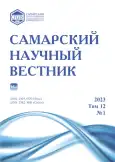Features and prospects for the introduction of mobile technologies in the process of teaching a foreign language in a non-linguistic university
- Authors: Nikolaeva E.A.1, Kotliarenko I.Y.2
-
Affiliations:
- Don State Technical University
- Rostov State Transport University
- Issue: Vol 12, No 1 (2023)
- Pages: 281-287
- Section: Pedagogical Sciences
- URL: https://journals.rcsi.science/2309-4370/article/view/133980
- DOI: https://doi.org/10.55355/snv2023121308
- ID: 133980
Cite item
Full Text
Abstract
This paper discusses the possibilities and prospects for the introduction of mobile learning technologies in the practice of teaching a foreign language to students of non-linguistic universities. The relevance of the study is due to the fact that the use of mobile devices is a natural process in the field of teaching foreign languages, and modern students have organically moved from listening and viewing foreign-language artifacts of mass culture to the purposeful use of mobile devices for learning foreign languages. The introduction of mobile technologies into the practice of learning foreign languages has formed a natural learning environment adapted to the interests of students. This state of affairs suggests that the process of teaching a foreign language using mobile devices should solve a number of serious problems, starting with issues related to the development of a motivation system for students to learn a foreign language, cognitive activity, and ending with the problems of forming a multilingual personality. On the other hand, new generation education standards require the development of IT competencies that allow introducing new formats into the traditional teaching practice, providing interactive support for the learning process and developing students’ communication skills in accordance with the requirements of the time. In this context, the purpose of the study was to evaluate the possibilities of introducing mobile learning technologies into the practice of teaching a foreign language to students of a non-linguistic university. The paper presents the results of a field study of the level of readiness of foreign language teachers to introduce mobile technologies into the practice of language training for students of non-linguistic universities. The conducted studies have shown that the main feature of the process of introducing mobile technologies into the practice of language training is its spontaneity and disorganization, and the prospects for their active use are limited by the level of mobile competence development among teachers. The results obtained can serve as a basis for further research into the problems of achieving the level of compliance of the IT competencies of foreign language teachers with the social orders of modern society.
Keywords
Full Text
##article.viewOnOriginalSite##About the authors
Elena Aleksandrovna Nikolaeva
Don State Technical University
Author for correspondence.
Email: yfcntyf12032009@yandex.ru
candidate of pedagogical sciences, associate professor of Foreign Language in the Field of Social Sciences and Humanities Department
Russian Federation, Rostov-on-DonIuliia Yuryevna Kotliarenko
Rostov State Transport University
Email: kotlakot@rambler.ru
candidate of pedagogical sciences, associate professor of Foreign Languages Department
Russian Federation, Rostov-on-DonReferences
- Twarog L.I., Pereszlenyi-Pinter M. Telephone-assisted language study at Ohio State University: a report // The Modern Language Journal. 1988. Vol. 72, iss. 4. P. 426–434. doi: 10.1111/j.1540-4781.1988.tb04204.x.
- Browne C., Culligan B. Combining technology and IRT testing to build student knowledge of high frequency vocabulary // The JALT CALL Journal. 2008. Vol. 4, № 2. P. 3–16. doi: 10.29140/jaltcall.v4n2.59.
- Chen N.-S., Hsieh S.-W., Kinshuk D. Effects of short-term memory and content representation type on mobile language learning // Language Learning & Technology. 2008. Vol. 12, № 3. P. 93–113.
- Thornton P., Houser C. Using mobile phones in English education in Japan // Journal of Computer Assisted Learning. 2005. Vol. 21, iss. 3. P. 217–228. doi: 10.1111/j.1365-2729.2005.00129.x.
- Stockwell G. Using mobile phones for vocabulary activities: examining the effect of platform // Language Learning and Technology. 2010. № 14 (2). P. 95–110.
- Stockwell G. Investigating learner preparedness for and usage patterns of mobile learning // ReCALL. 2008. Vol. 20, iss. 3. P. 253–270. doi: 10.1017/s0958344008000232.
- Серостанова Н.Н., Чопорова Е.И. Современные технологии преподавания иностранных языков в эпоху цифровизации образования // Современные проблемы науки и образования. 2020. № 6. doi: 10.17513/spno.30254.
- Титова С.В. Дидактические проблемы интеграции мобильных приложений в учебный процесс // Вестник Тамбовского университета. Серия: Гуманитарные науки. 2016. Т. 21, вып. 7–8 (159–160). С. 7–14. doi: 10.20310/1810-0201-2016-21-7/8(159/160)-7-14.
- Koole M. A model for framing mobile learning // Mobile learning: transforming the delivery of education & training. Ch. 2 / ed.: M. Ally. Athabasca: Athabasca University Press, 2009. P. 25–47.
- Kukulska-Hulme A., Norris L., Donohue J. Mobile pedagogy for English language teaching: a guide for teachers. London: The Open University. British Council, 2015. 48 p.
- Трошина Ю.В., Вербицкая Н.О. Мобильное обучение иностранному языку: понятие, функции, модели [Электронный ресурс] // Современные проблемы науки и образования. 2015. № 3. https://science-education.ru/ru/article/view?id=20164.
- Касаткина Н.Н. Модели мобильного обучения иностранному языку // Ярославский педагогический вестник. 2017. № 1. С. 88–91.
- Churches A. Bloom's digital taxonomy [Internet] // http://burtonslifelearning.pbworks.com/f/BloomDigitalTaxonomy2001.pdf.
- Puentedura R.R. SAMR and TPCK in action [Internet] // http://www.hippasus.com/rrpweblog/archives/2011/10/28/SAMR_TPCK_In_Action.pdf.
- Данилова Л.Н. Цифровизация обучения иностранным языкам в вузе: возможности и риски // Профессиональное образование в России и за рубежом. 2021. № 1 (41). С. 119–128.
- Гвоздева А.В. Теоретико-дидактические основы смешанного обучения в вузе // Ученые записки. Электронный научный журнал Курского государственного университета. 2020. № 4 (56). С. 207–213.
- Simonova I. Mobile technologies for foreign language learning // International Journal on Language, Literature and Culture in Education. 2016. Vol. 3 (1). P. 25–39. doi: 10.1515/llce-2016-0002.
- Колыхматов В.И. Цифровая грамотность и навыки современного педагога // Ученые записки университета имени П.Ф. Лесгафта. 2020. № 8 (186). С. 156–160. doi: 10.34835/issn.2308-1961.2020.8.p156-160.
- Hockly N. Digital literacies // ELT Journal. 2012. Vol. 66, iss. 1. P. 108–112. doi: 10.1093/elt/ccr077.
- Авраменко А.П. Модель интеграции мобильных технологий в преподавание иностранных языков для развития устных видов речевой деятельности (английский язык): автореф. дис. … канд. пед. наук: 13.00.02. М., 2013. 23 с.








